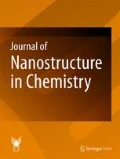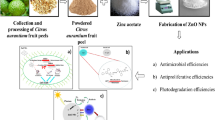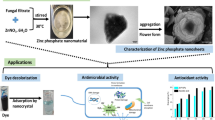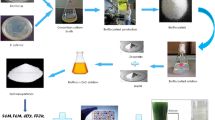Abstract
An efficient bio-conditioning of the nanomaterial for microbial inhibition and catalytic degradation has been recognized as a promising solution to protect public health and environmental safety. Herein, a bio-conditioned poly-dihydromyricetin-fused zinc nanoparticles (PDMY-Zn NPs) were designed and constructed based on a green tonic approach, which displays excellent processing efficiency against Escherichia coli (E. coli) and Staphylococcus aureus (S. aureus) as well as three dye effluents. Irregular-shaped PDMY-Zn NPs of size range 300–400 nm were formed by the undirected aggregation between Zn2+ and dihydromyricetin (DMY) isolated from Ampelopsis grossedentata, contributing to the controlled release of Zn2+ in gastrointestinal fluid. Such bio-conditioned nanomaterial relied on the stable and strong interaction between the bacterial membrane and carbohydrate polymeric DMY chain in PDMY-Zn NPs achieves a large amount of adhesion to both E. coli and S. aureus, which allows the targeted detachment of Zn2+ from nanoparticles and accurate penetration into the pathogens, thereby achieving the nontoxicity to normal cells and minimizing drug-resistant bacteria. The division and spread of E. coli and S. aureus treated with PDMY-Zn NPs were effectively restricted and halted owing to multidimensional antibacterial behaviors of bacteriostatic agents, which are reflected in membrane damage, high cellular leakages and destroying intracellular ATP. Moreover, the designed PDMY-Zn NPs exhibit an efficient generation of hydroxyl (OH) and excess superoxide, which support it as a promising catalyst for photodegradation of methyl blue (93.02%), methyl orange (93.02%) and safranine (88.3%). Thus, this novel bio-conditioned nanomaterial provides a stable, nontoxic and advanced strategy to address drug-resistant bacteria infections as well as degradation of toxic dye effluents.








Similar content being viewed by others
References
Capeletti, L.B., Oliveira, J.F.A., Loiola, L.M.D., Galdino, F.E., Silva Santos, D.E., Soares, T.A., Oliveira Freitas, R., Cardoso, M.B.: Gram-negative bacteria targeting mediated by carbohydrate-carbohydrate interactions induced by surface-modified nanoparticles. Adv. Funct. Mater. 29, 1904216 (2019)
Willyard, C.: The drug-resistant bacteria that pose the greatest health threats. Nature 543, 15 (2017)
Ogawara, H.: Possible drugs for the treatment of bacterial infections in the future: anti-virulence drugs. J. Antibiot. (Tokyo). 74, 24–41 (2021)
Levin-Reisman, I., Ronin, I., Gefen, O., Braniss, I., Shoresh, N., Balaban, N.Q.: Antibiotic tolerance facilitates the evolution of resistance. Science 335, 826–830 (2017)
Xin, Q., Shah, H., Nawaz, A., Xie, W., Akram, M.Z., Batool, A., Tian, L., Jan, S.U., Boddula, R., Guo, B., Liu, Q., Gong, J.R.: Antibacterial carbon-based nanomaterials. Adv. Mater. 31, e1804838 (2019)
Christaki, E., Marcou, M., Tofarides, A.: Antimicrobial resistance in bacteria: mechanisms, evolution, and persistence. J. Mol. Evol. 88, 26–40 (2020)
Xiang, W., Zhang, X., Chen, J., Zou, W., He, F., Hu, X., Tsang, D.C.W., Ok, Y.S., Gao, B.: Biochar technology in wastewater treatment: a critical review. Chemosphere 252, 126539 (2020)
Donkadokula, N.Y., Kola, A.K., Naz, I., Saroj, D.: A review on advanced physico-chemical and biological textile dye wastewater treatment techniques. Rev. Environ. Sci. Biotechnol. 19, 543–560 (2020)
Qasim, S., Zafar, A., Saif, M.S., Ali, Z., Nazar, M., Waqas, M., Haq, A.U., Tariq, T., Hassan, S.G., Iqbal, F., Shu, X.G., Hasan, M.: Green synthesis of iron oxide nanorods using Withania coagulans extract improved photocatalytic degradation and antimicrobial activity. J. Photochem. Photobiol. B. 204, 111784 (2020)
Weldegebrieal, G.K.: Synthesis method, antibacterial and photocatalytic activity of ZnO nanoparticles for azo dyes in wastewater treatment: a review. Inorg. Chem. Commun. 120, 108140 (2020)
Khan, S.A., Noreen, F., Kanwal, S., Iqbal, A., Hussain, G.: Green synthesis of ZnO and Cu-doped ZnO nanoparticles from leaf extracts of Abutilon indicum, Clerodendrum infortunatum, Clerodendrum inerme and investigation of their biological and photocatalytic activities. Mater. Sci. Eng. C Mater. Biol. Appl. 82, 46–59 (2018)
Luo, F., Wang, M., Huang, L., Wu, Z., Wang, W., Zafar, A., Tian, Y., Hasan, M., Shu, X.: Synthesis of zinc oxide eudragit FS30D nanohybrids: structure, characterization, and their application as an intestinal drug delivery system. ACS Omega 5, 11799–11808 (2020)
Ebrahimzadeh, M.A., Naghizadeh, A., Amiri, O., Shirzadi-Ahodashti, M., Mortazavi-Derazkola, S.: Green and facile synthesis of Ag nanoparticles using Crataegus pentagyna fruit extract (CP-AgNPs) for organic pollution dyes degradation and antibacterial application. Bioorg. Chem. 94, 103425 (2020)
Slavin, Y.N., Asnis, J., Hafeli, U.O., Bach, H.: Metal nanoparticles: understanding the mechanisms behind antibacterial activity. J. Nanobiotechnol. 15, 65 (2017)
Manges, A.R., Geum, H.M., Guo, A., Edens, T.J., Fibke, C.D., Pitout, J.D.D.: Global extraintestinal pathogenic Escherichia coli (ExPEC) lineages. Clin. Microbiol. Rev. 32, e00135-e1118 (2019)
Li, X., Bai, H., Yang, Y., Yoon, J., Wang, S., Zhang, X.: Supramolecular antibacterial materials for combatting antibiotic resistance. Adv. Mater. 31, e1805092 (2019)
Marreiro, D.D., Cruz, K.J., Morais, J.B., Beserra, J.B., Severo, J.S., de Oliveira, A.R.: Zinc and oxidative stress: current mechanisms. Antioxidants (Basel). 6, 24–33 (2017)
Elfeky, A.S., Salem, S.S., Elzaref, A.S., Owda, M.E., Eladawy, H.A., Saeed, A.M., Awad, M.A., Abou-Zeid, R.E., Fouda, A.: Multifunctional cellulose nanocrystal /metal oxide hybrid, photo-degradation, antibacterial and larvicidal activities. Carbohydr. Polym. 230, 115711 (2020)
Rambabu, K., Bharath, G., Banat, F., Show, P.L.: Green synthesis of zinc oxide nanoparticles using Phoenix dactylifera waste as bioreductant for effective dye degradation and antibacterial performance in wastewater treatment. J. Hazard Mater. 402, 123560 (2021)
Saratale, G.D., Saratale, R.G., Cho, S.-K., Ghodake, G., Bharagava, R.N., Park, Y., Mulla, S.I., Kim, D.-S., Kadam, A., Nair, S., Shin, H.-S.: Investigation of photocatalytic degradation of reactive textile dyes by Portulaca oleracea-functionalized silver nanocomposites and exploration of their antibacterial and antidiabetic potentials. J. Alloys Compd. 833, 155083 (2020)
Muthuvel, A., Jothibas, M., Mohana, V., Manoharan, C.: Green synthesis of cerium oxide nanoparticles using Calotropis procera flower extract and their photocatalytic degradation and antibacterial activity. Inorg. Chem. Commun. 119, 108086 (2020)
Brown, E.D., Wright, G.D.: Antibacterial drug discovery in the resistance era. Nature 529, 336–343 (2016)
Cushnie, T.P., Cushnie, B., Lamb, A.J.: Alkaloids: an overview of their antibacterial, antibiotic-enhancing and antivirulence activities. Int. J. Antimicrob. Agents. 44, 377–386 (2014)
Hasan, M., Altaf, M., Zafar, A., Hassan, S.G., Ali, Z., Mustafa, G., Munawar, T., Saif, M.S., Tariq, T., Iqbal, F., Khan, M.W., Mahmood, A., Mahmood, N., Shu, X.: Bioinspired synthesis of zinc oxide nano-flowers: a surface enhanced antibacterial and harvesting efficiency. Mater. Sci. Eng. C. Mater. Biol. Appl. 119, 111280 (2021)
Yousaf, A., Zafar, A., Ali, M., Bukhary, S.M., Manzoor, Y., Tariq, T., Saeed, A., Akram, M., Bukhari, F., Abdullah, M., Zehra, S.S., Hassan, S.G., Hasan, M.: Intrinsic bio-enhancer entities of Fagonia cretica for synthesis of silver nanoparticles involves anti-urease, anti-oxidant and anti-tyosinase activity. Adv. Biosci. Biotechnol. 10, 455–468 (2019)
Dong, J., Li, H., Min, W.: Preparation, characterization and bioactivities of Athelia rolfsii exopolysaccharide-zinc complex (AEPS-zinc). Int. J. Biol. Macromol. 113, 20–28 (2018)
Zheng, L., Zhai, G., Zhang, J., Wang, L., Ma, Z., Jia, M., Jia, L.: Antihyperlipidemic and hepatoprotective activities of mycelia zinc polysaccharide from Pholiota nameko SW-02. Int. J. Biol. Macromol. 70, 523–529 (2014)
Lu, Q., Xu, L., Meng, Y., Liu, Y., Li, J., Zu, Y., Zhu, M.: Preparation and characterization of a novel Astragalus membranaceus polysaccharide-iron (III) complex. Int. J. Biol. Macromol. 93, 208–216 (2016)
Shen, C., James, S.A., de Jonge, M.D., Turney, T.W., Wright, P.F., Feltis, B.N.: Relating cytotoxicity, zinc ions, and reactive oxygen in ZnO nanoparticle-exposed human immune cells. Toxicol. Sci. 136, 120–130 (2013)
Fan, W., Sun, Q., Li, Y., Tay, F.R., Fan, B.: Synergistic mechanism of Ag(+)-Zn(2+) in anti-bacterial activity against Enterococcus faecalis and its application against dentin infection. J. Nanobiotechnol. 16, 10 (2018)
Ishida, T.: Antibacterial mechanism of bacteriolyses of bacterial cell walls by zinc (II) ion induced activations of PGN autolysins, and DNA damages. J. Genes Proteins 1, 1 (2017)
Liao, W., Ning, Z., Ma, L., Yin, X., Wei, Q., Yuan, E., Yang, J., Ren, J.: Recrystallization of dihydromyricetin from Ampelopsis grossedentata and its anti-oxidant activity evaluation. Rejuven. Res. 17, 422–429 (2014)
Hou, X.L., Tong, Q., Wang, W.Q., Shi, C.Y., Xiong, W., Chen, J., Liu, X., Fang, J.G.: Suppression of inflammatory responses by dihydromyricetin, a flavonoid from Ampelopsis grossedentata, via inhibiting the activation of NF-κB and MAPK signaling pathways. J. Nat. Prod. 78, 1689–1696 (2015)
Fan, L., Tong, Q., Dong, W., Yang, G., Hou, X., Xiong, W., Shi, C., Fang, J., Wang, W.: Tissue distribution, excretion, and metabolic profile of dihydromyricetin, a flavonoid from vine tea (Ampelopsis grossedentata) after oral administration in rats. J. Agric. Food Chem. 65, 4597–4604 (2017)
Liu, D., Mao, Y., Ding, L., Zeng, X.A.: Dihydromyricetin: a review on identification and quantification methods, biological activities, chemical stability, metabolism and approaches to enhance its bioavailability. Trends Food Sci. Technol. 91, 586–597 (2019)
Luo, F., Tang, F., Xu, Y., Wang, M., Yang, Y., Zou, S., Tian, Y., Shu, X., Fu, Z.: Green synthesis of ZnO nanoparticles using flavone from Ampelopsis grossedentata and its antioxidant and antibacterial properties. Fine Chem. 37, 1793–1798 (2020). (+1832)
Arjunan, N., Kumari, H.L., Singaravelu, C.M., Kandasamy, R., Kandasamy, J.: Physicochemical investigations of biogenic chitosan-silver nanocomposite as antimicrobial and anticancer agent. Int. J. Biol. Macromol. 92, 77–87 (2016)
Gao, F., Zhou, H., Shen, Z., Zhu, G., Hao, L., Chen, H., Xu, H., Zhou, X.: Long-lasting anti-bacterial activity and bacteriostatic mechanism of tea tree oil adsorbed on the amino-functionalized mesoporous silica-coated by PAA. Colloids Surf. B Biointerfaces 188, 110784 (2020)
Shen, S., Zhang, T., Yuan, Y., Lin, S., Xu, J., Ye, H.: Effects of cinnamaldehyde on Escherichia coli and Staphylococcus aureus membrane. Food Control 47, 196–202 (2015)
Li, J., Chen, Z., Zhou, M., Jing, J., Li, W., Wang, Y., Wu, L., Wang, L., Wang, Y., Lee, M.: Polyoxometalate-driven self-assembly of short peptides into multivalent nanofibers with enhanced antibacterial activity. Angew. Chem. Int. Ed. Engl. 55, 2592–2595 (2016)
Moustafine, R.I., Sitenkov, A.Y., Bukhovets, A.V., Nasibullin, S.F., Appeltans, B., Kabanova, T.V., Khutoryanskiy, V.V., Van den Mooter, G.: Indomethacin-containing interpolyelectrolyte complexes based on Eudragit((R)) E PO/S 100 copolymers as a novel drug delivery system. Int. J. Pharm. 524, 121–133 (2017)
Wang, C., Xiong, W., Reddy Perumalla, S., Fang, J., Calvin Sun, C.: Solid-state characterization of optically pure (+)Dihydromyricetin extracted from Ampelopsis grossedentata leaves. Int. J. Pharm. 511, 245–252 (2016)
Xu, P.-Y., Fu, C.-P., Kankala, R.K., Wang, S.-B., Chen, A.-Z.: Supercritical carbon dioxide-assisted nanonization of dihydromyricetin for anticancer and bacterial biofilm inhibition efficacies. J. Supercrit Fluids. 161, 104840 (2020)
Bukhari, S.B., Memon, S., Mahroof-Tahir, M., Bhanger, M.I.: Synthesis, characterization and antioxidant activity copper-quercetin complex. Spectrochim. Acta A Mol. Biomol. Spectrosc. 71, 1901–1906 (2009)
Guo, Q., Yuan, J., Zeng, J., He, X., Li, D.: Synthesis of dihydromyricetin–manganese (II) complex and interaction with DNA. J. Mol. Struct. 1027, 64–69 (2012)
Pan, H.L., Liu, Q.Q., Zhang, Y.H., Wu, H.T.: Crystal structure and microwave dielectric characteristics of Zr-substituted CoTiNb2O8 ceramics. RSC Adv. 6, 86889–86903 (2016)
Ly, N.H., Joo, S.-W.: Zn(II)-concentration dependent Raman spectra in the dithizone complex on gold nanoparticle surfaces in environmental water samples. Appl. Surf. Sci. 356, 1005–1011 (2015)
Pramanik, A., Maiti, S., Dhawa, T., Sreemany, M., Mahanty, S.: High faradaic charge storage in ZnCo2S4 film on Ni-foam with a hetero-dimensional microstructure for hybrid supercapacitor. Mater. Today Energy 9, 416–427 (2018)
Pan, C., Ou, M., Cheng, Q., Zhou, Y., Yu, Y., Li, Z., Zhang, F., Xia, D., Mei, L., Ji, X.: Z-scheme heterojunction functionalized pyrite nanosheets for modulating tumor microenvironment and strengthening photo/chemodynamic therapeutic effects. Adv. Funct. Mater. 30, 1906466 (2019)
Dutta, S., Ray, C., Negishi, Y., Pal, T.: Facile synthesis of unique hexagonal nanoplates of Zn/Co hydroxy sulfate for efficient electrocatalytic oxygen evolution reaction. ACS Appl. Mater. Interfaces 9, 8134–8141 (2017)
Ghosh, N.G., Sarkar, A., Zade, S.S.: The type-II n–n inorganic/organic nano-heterojunction of Ti3+ self-doped TiO2 nanorods and conjugated co-polymers for photoelectrochemical water splitting and photocatalytic dye degradation. Chem. Eng. J. 407, 127227 (2021)
Javed, M.S., Shaheen, N., Hussain, S., Li, J., Shah, S.S.A., Abbas, Y., Ahmad, M.A., Raza, R., Mai, W.: An ultra-high energy density flexible asymmetric supercapacitor based on hierarchical fabric decorated with 2D bimetallic oxide nanosheets and MOF-derived porous carbon polyhedra. J. Mater. Chem. A. 7, 946–957 (2019)
Yang, S.J., Kim, T., Im, J.H., Kim, Y.S., Lee, K., Jung, H., Park, C.R.: MOF-derived hierarchically porous carbon with exceptional porosity and hydrogen storage capacity. Chem. Mater. 24, 464–470 (2012)
Xiao, H., Zhang, Z.P., Huang, Z.X., Rong, M.Z., Zhang, M.Q.: Highly thermally conductive, superior flexible and surface metallisable boron nitride paper fabricated by a facile and scalable approach. Compos. Commun. 23, 100584 (2021)
Liu, H., Xia, G., Zhang, R., Jiang, P., Chen, J., Chen, Q.: MOF-derived RuO2/Co3O4 heterojunctions as highly efficient bifunctional electrocatalysts for HER and OER in alkaline solutions. RSC Adv. 7, 3686–3694 (2017)
Zhang, M., Zhao, H., Shen, Y., Wang, Y., Zhao, Z., Zhang, Y.: Preparation, characterization and antioxidant activity evaluation in vitro of Fritillaria ussuriensis polysaccharide-zinc complex. Int. J. Biol. Macromol. 146, 462–474 (2020)
Hasan, M., Yang, W., Ju, Y., Chu, X., Wang, Y., Deng, Y., Mahmood, N., Hou, Y.: Biocompatibility of iron carbide and detection of metals ions signaling proteomic analysis via HPLC/ESI-Orbitrap. Nano Res. 10, 1912–1923 (2017)
Wang, J., Wang, A., Wang, W.-X.: Evaluation of nano-ZnOs as a novel Zn source for marine fish: importance of digestive physiology. Nanotoxicology 11, 1026–1039 (2017)
Xiang, D., Wang, C.G., Wang, W.Q., Shi, C.Y., Xiong, W., Wang, M.D., Fang, J.G.: Gastrointestinal stability of dihydromyricetin, myricetin, and myricitrin: an in vitro investigation. Int. J. Food Sci. Nutr. 68, 704–711 (2017)
Wang, N., Tong, T., Xie, M., Gaillard, J.F.: Lifetime and dissolution kinetics of zinc oxide nanoparticles in aqueous media. Nanotechnology 27, 324001 (2016)
Bharathi, D., Ranjithkumar, R., Chandarshekar, B., Bhuvaneshwari, V.: Preparation of chitosan coated zinc oxide nanocomposite for enhanced antibacterial and photocatalytic activity: as a bionanocomposite. Int. J. Biol. Macromol. 129, 989–996 (2019)
Wu, Y., Bai, J., Zhong, K., Huang, Y., Gao, H.: A dual antibacterial mechanism involved in membrane disruption and DNA binding of 2R,3R-dihydromyricetin from pine needles of Cedrus deodara against Staphylococcus aureus. Food Chem. 218, 463–470 (2017)
Xu, Y., Shi, Y., Lei, F., Dai, L.: A novel and green cellulose-based Schiff base-Cu (II) complex and its excellent antibacterial activity. Carbohydr. Polym. 230, 115671 (2020)
Verlee, A., Mincke, S., Stevens, C.V.: Recent developments in antibacterial and antifungal chitosan and its derivatives. Carbohydr. Polym. 164, 268–283 (2017)
Caroff, M., Karibian, D.: Structure of bacterial lipopolysaccharides. Carbohydr. Res. 338, 2431–2447 (2003)
Mahmoudi, M., Bertrand, N., Zope, H., Farokhzad, O.C.: Emerging understanding of the protein corona at the nano-bio interfaces. Nano Today 11, 817–832 (2016)
Arita-Morioka, K., Yamanaka, K., Mizunoe, Y., Ogura, T., Sugimoto, S.: Novel strategy for biofilm inhibition by using small molecules targeting molecular chaperone DnaK. Antimicrob. Agents Chemother. 59, 633–641 (2015)
Bai, H., Fu, X., Huang, Z., Lv, F., Liu, L., Zhang, X., Wang, S.: Supramolecular germicide switches through host-guest interactions for decelerating emergence of drug-resistant pathogens. Chem. Select 2, 7940–7945 (2017)
Hasan, M., Ullah, I., Zulfiqar, H., Naeem, K., Iqbal, A., Gul, H., Ashfaq, M., Mahmood, N.: Biological entities as chemical reactors for synthesis of nanomaterials: progress, challenges and future perspective. Mater. Today Chem. 8, 13–28 (2018)
Bajpai, V.K., Sharma, A., Baek, K.-H.: Antibacterial mode of action of Ginkgo biloba leaf essential oil: effect on morphology and membrane permeability. Bangladesh J. Pharmacol. 10, 337–350 (2015)
McQuillan, J.S., Infante, H.G., Stokes, E., Shaw, A.M.: Silver nanoparticle enhanced silver ion stress response in Escherichia coli K12. Nanotoxicology 6, 857–866 (2012)
Mishra, P.K., Mishra, H., Ekielski, A., Talegaonkar, S., Vaidya, B.: Zinc oxide nanoparticles: a promising nanomaterial for biomedical applications. Drug Discov. Today 22, 1825–1834 (2017)
Vimbela, G.V., Ngo, S.M., Fraze, C., Yang, L., Stout, D.A.: Antibacterial properties and toxicity from metallic nanomaterials. Int. J. Nanomed. 12, 3941–3965 (2017)
Song, J., Chen, H., Wei, Y., Liu, J.: Synthesis of carboxymethylated beta-glucan from naked barley bran and its antibacterial activity and mechanism against Staphylococcus aureus. Carbohydr. Polym. 242, 116418 (2020)
Hobman, J.L., Crossman, L.C.: Bacterial antimicrobial metal ion resistance. J. Med. Microbiol. 64, 471–497 (2015)
Nguyen, C.H., Fu, C.-C., Juang, R.-S.: Degradation of methylene blue and methyl orange by palladium-doped TiO2 photocatalysis for water reuse: efficiency and degradation pathways. J. Clean Prod. 202, 413–427 (2018)
Acknowledgements
The authors gratefully appreciate the financial support from Guangdong-Hong Kong Cooperation Project (2017A050506055), the Guangdong Provincial Education Department Project (2017KZDXM045, 2017KTSCX098), Guangdong Provincial Department of Agriculture and Rural Affairs Project (2020KJ115, 2021KJ115), the Guangzhou Foreign Cooperation Project (201907010033), Guangdong Province Science and Technology Project (2016A020210066).
Author information
Authors and Affiliations
Contributions
All authors do not have any financial and personal relationships with other people or organizations.
Corresponding authors
Ethics declarations
Conflict of interest
The authors declare that they have no known competing financial interests or personal relationships that could have appeared to influence the work reported in this paper.
Additional information
Publisher's Note
Springer Nature remains neutral with regard to jurisdictional claims in published maps and institutional affiliations.
Supplementary Information
Below is the link to the electronic supplementary material.
Rights and permissions
About this article
Cite this article
Luo, F., Zeng, D., Wang, W. et al. Bio-conditioning poly-dihydromyricetin zinc nanoparticles synthesis for advanced catalytic degradation and microbial inhibition. J Nanostruct Chem 12, 903–917 (2022). https://doi.org/10.1007/s40097-021-00443-4
Received:
Accepted:
Published:
Issue Date:
DOI: https://doi.org/10.1007/s40097-021-00443-4




